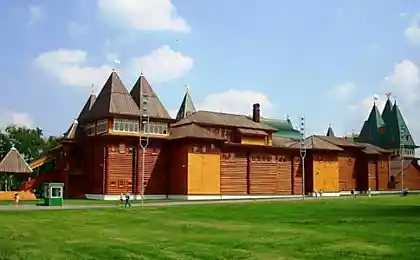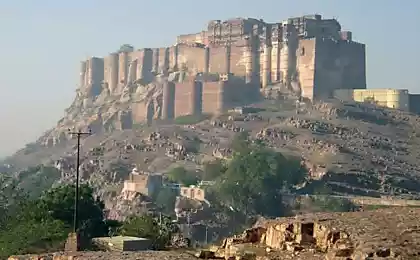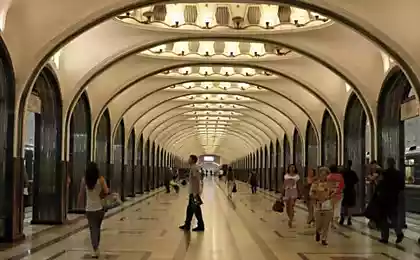2244
Moscow. Virtual Palace of Soviets.
Let's take virtual trips takes a little around the Palace of Soviets in Moscow. Grand and majestic building has never come to fruition. On the Internet there are illustrations from sketch and design documentation of the Palace of the Soviets and set these illustrations is limited. The idea to restore one of the variants of this building in 3d, describe the history of the Palace of Soviets, and stroll through the territory of a virtual building. At the end of the post shows the evolution of the winning project of the Palace of Soviets Boris Iofana, since 1933. The 3d version implemented in 1934.

The history of the Palace of Soviets phantom
The idea of construction of the Palace of Soviets in the next year will be 90 years. In 1931 he was declared an open competition to design the building. According to the plan, the Palace of the Soviets was to embody the greatness, the power and success of the young Soviet state, to become visible embodiment of the idea of the victory of communism, all prepared for a bright future. The competition received about 160-minute projects both from foreign architects, and, for the most part, from the Soviet. By the time the dominant element of architecture was constructivism. At the heart of constructivism are strict, laconic forms and the space of the building should be as functional. No small part of the projects for the construction of the Palace of Soviets was couched in the constructivist spirit. But for building symbol concise and rational form of bad fit me "proletarian aesthetics." At least so thought Josef Stalin. Simplicity and skeptical design structures have been replaced by pompous, richly decorate the facades. Architects, based on the development of classical forms is increasingly asserting itself. Apart from other architects kept Boris lofan. Apprentice Italian architect Armando Brazini won the competition for the Palace of Soviets. By the way, the competition Brazini also participated. The impact was a great teacher, one might even say that in the upcoming Palace was leaking and Italian blood. after the Italian Kremlin, became the sacred center of Russia, the significant influence of the Italians in the Orthodox church structures was time architectural influence on the country of the Soviets.
In 1933, the work of B. Iofana hooked architects V. and V. Shuko Gelfreich. By being prepared to revise the draft of the Palace of the height was to be 420 meters, crowned the building was 100 meter monument to VI Lenin - the work of sculptor S. Merkurov. The cubic capacity of the building amounted to 7.5 million cubic meters. Great Hall of the Palace was designed for 21,000 people, had a height of 100 meters, a small room was designed for 6,000. In the high part of the Palace had to stay in the Presidency, the Chambers of the Supreme Soviet of the USSR and some other rooms.
The construction of such a building would require reorganization of Volkhonka and other surrounding buildings. In other words, all the historical buildings, mansions would carry. Large areas around the proposed asphalt and equip parking for 5000 cars. The building of the Pushkin Museum. AS Pushkin had to move 100 meters.
The construction of the Palace began in the late 30s on the site of the destroyed Cathedral of Christ the Savior. But the truly ambitious plan of the Bolsheviks and was destined to fail. The war brought about changes. Construction was halted at the stage of laying the foundation. Interestingly, during and after the war, the Palace of the Soviets underwent change, hope for the project for a long time did not leave Stalin. The post-war devastation, the death of the leader, the Stalinization adoption of the directive on "the condemnation of decorations and architectural excesses" finally buried the idea and the project of further construction. Then there were a lot of other programs and projects, attempts to both successful and unsuccessful to oppose the Soviet Union and the socialist camp and the capital of the world market economy. But such a beautiful design in architecture is no longer there.
The project of the Palace of the Board Boris Iofana played a major role in the establishment and further development and flourishing of Soviet architecture '30s -' 50s, called "Stalin's empire." Educated at the crossroads of different cultures and styles, from classical to postconstructivism talented synthesis of architecture, eclectic Soviet imperial style - a significant milestone in the architecture world.

The idea of construction of the Palace of Soviets in the next year will be 90 years. In 1931 he was declared an open competition to design the building. According to the plan, the Palace of the Soviets was to embody the greatness, the power and success of the young Soviet state, to become visible embodiment of the idea of the victory of communism, all prepared for a bright future. The competition received about 160-minute projects both from foreign architects, and, for the most part, from the Soviet. By the time the dominant element of architecture was constructivism. At the heart of constructivism are strict, laconic forms and the space of the building should be as functional. No small part of the projects for the construction of the Palace of Soviets was couched in the constructivist spirit. But for building symbol concise and rational form of bad fit me "proletarian aesthetics." At least so thought Josef Stalin. Simplicity and skeptical design structures have been replaced by pompous, richly decorate the facades. Architects, based on the development of classical forms is increasingly asserting itself. Apart from other architects kept Boris lofan. Apprentice Italian architect Armando Brazini won the competition for the Palace of Soviets. By the way, the competition Brazini also participated. The impact was a great teacher, one might even say that in the upcoming Palace was leaking and Italian blood. after the Italian Kremlin, became the sacred center of Russia, the significant influence of the Italians in the Orthodox church structures was time architectural influence on the country of the Soviets.
In 1933, the work of B. Iofana hooked architects V. and V. Shuko Gelfreich. By being prepared to revise the draft of the Palace of the height was to be 420 meters, crowned the building was 100 meter monument to VI Lenin - the work of sculptor S. Merkurov. The cubic capacity of the building amounted to 7.5 million cubic meters. Great Hall of the Palace was designed for 21,000 people, had a height of 100 meters, a small room was designed for 6,000. In the high part of the Palace had to stay in the Presidency, the Chambers of the Supreme Soviet of the USSR and some other rooms.
The construction of such a building would require reorganization of Volkhonka and other surrounding buildings. In other words, all the historical buildings, mansions would carry. Large areas around the proposed asphalt and equip parking for 5000 cars. The building of the Pushkin Museum. AS Pushkin had to move 100 meters.
The construction of the Palace began in the late 30s on the site of the destroyed Cathedral of Christ the Savior. But the truly ambitious plan of the Bolsheviks and was destined to fail. The war brought about changes. Construction was halted at the stage of laying the foundation. Interestingly, during and after the war, the Palace of the Soviets underwent change, hope for the project for a long time did not leave Stalin. The post-war devastation, the death of the leader, the Stalinization adoption of the directive on "the condemnation of decorations and architectural excesses" finally buried the idea and the project of further construction. Then there were a lot of other programs and projects, attempts to both successful and unsuccessful to oppose the Soviet Union and the socialist camp and the capital of the world market economy. But such a beautiful design in architecture is no longer there.
The project of the Palace of the Board Boris Iofana played a major role in the establishment and further development and flourishing of Soviet architecture '30s -' 50s, called "Stalin's empire." Educated at the crossroads of different cultures and styles, from classical to postconstructivism talented synthesis of architecture, eclectic Soviet imperial style - a significant milestone in the architecture world. & quot; / & gt;
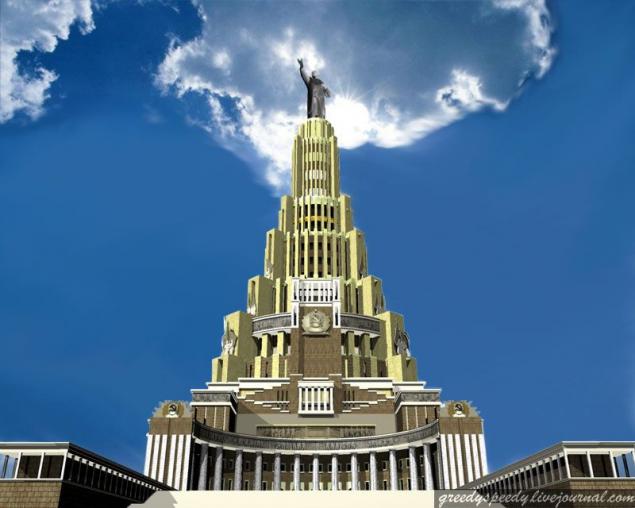





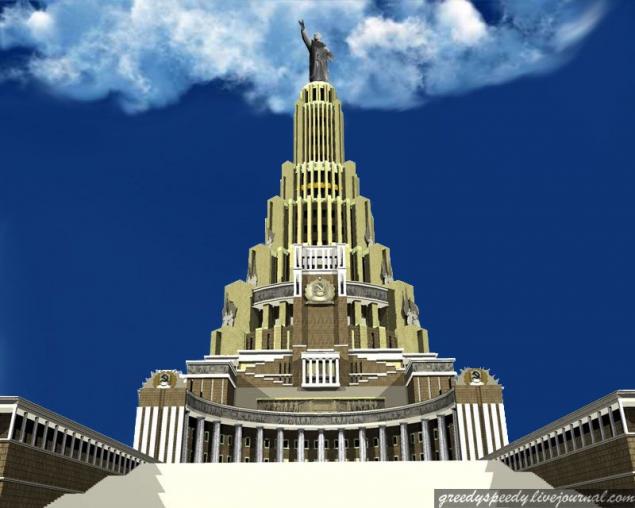






Evolution of the Palace of the Board Boris Iofana et al.

1. The Palace of Soviets in Moscow. Boris lofan, Vladimir Shuko Vladimir Gelfreich. Option 1933
2. Palace of Soviets in Moscow. B. lofan, VA Shuko, V. Gelfreich. Option '34.

3. Palace of Soviets in Moscow. B. lofan, VA Shuko, V. Gelfreich. Option '34.
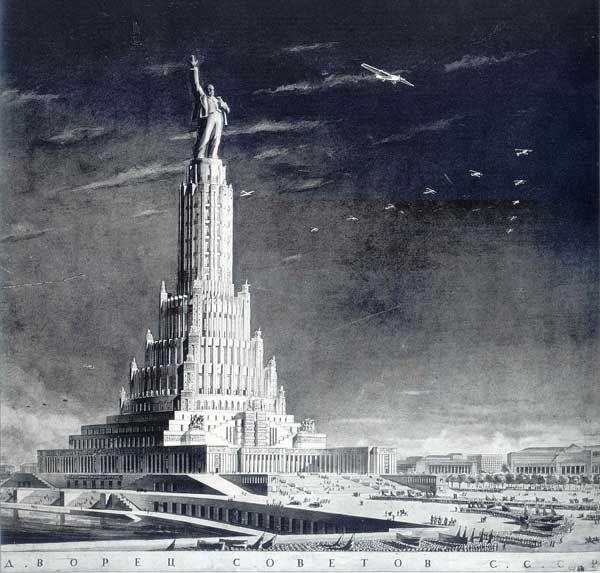
4. Palace of Soviets in Moscow. Boris lofan, Vladimir Shuko Vladimir Gelfreich. Option 1937.

It is this version of the author prigdlyanulsya most, and it was decided to implement in 3d.
5. Palace of Soviets in Moscow. B. lofan, VA Shuko, V. Gelfreich. Variant 43-45 years. In this edition, most likely there is an error: in 1939, died Vladimir A. Shuko. Correspondingly, in the period from 1943 to 1945 could prnimat part in the project, or his son, George V. Shuko, or this option belongs to another period, either the father or son is not taking part in the project.

6. Palace of Councils. B. lofan V. Gelfreich, Ya.Belopolsky, V. Pelevin. Sculptor S. Mercury. One embodiment of the approved project. 1946

via source

The history of the Palace of Soviets phantom
The idea of construction of the Palace of Soviets in the next year will be 90 years. In 1931 he was declared an open competition to design the building. According to the plan, the Palace of the Soviets was to embody the greatness, the power and success of the young Soviet state, to become visible embodiment of the idea of the victory of communism, all prepared for a bright future. The competition received about 160-minute projects both from foreign architects, and, for the most part, from the Soviet. By the time the dominant element of architecture was constructivism. At the heart of constructivism are strict, laconic forms and the space of the building should be as functional. No small part of the projects for the construction of the Palace of Soviets was couched in the constructivist spirit. But for building symbol concise and rational form of bad fit me "proletarian aesthetics." At least so thought Josef Stalin. Simplicity and skeptical design structures have been replaced by pompous, richly decorate the facades. Architects, based on the development of classical forms is increasingly asserting itself. Apart from other architects kept Boris lofan. Apprentice Italian architect Armando Brazini won the competition for the Palace of Soviets. By the way, the competition Brazini also participated. The impact was a great teacher, one might even say that in the upcoming Palace was leaking and Italian blood. after the Italian Kremlin, became the sacred center of Russia, the significant influence of the Italians in the Orthodox church structures was time architectural influence on the country of the Soviets.
In 1933, the work of B. Iofana hooked architects V. and V. Shuko Gelfreich. By being prepared to revise the draft of the Palace of the height was to be 420 meters, crowned the building was 100 meter monument to VI Lenin - the work of sculptor S. Merkurov. The cubic capacity of the building amounted to 7.5 million cubic meters. Great Hall of the Palace was designed for 21,000 people, had a height of 100 meters, a small room was designed for 6,000. In the high part of the Palace had to stay in the Presidency, the Chambers of the Supreme Soviet of the USSR and some other rooms.
The construction of such a building would require reorganization of Volkhonka and other surrounding buildings. In other words, all the historical buildings, mansions would carry. Large areas around the proposed asphalt and equip parking for 5000 cars. The building of the Pushkin Museum. AS Pushkin had to move 100 meters.
The construction of the Palace began in the late 30s on the site of the destroyed Cathedral of Christ the Savior. But the truly ambitious plan of the Bolsheviks and was destined to fail. The war brought about changes. Construction was halted at the stage of laying the foundation. Interestingly, during and after the war, the Palace of the Soviets underwent change, hope for the project for a long time did not leave Stalin. The post-war devastation, the death of the leader, the Stalinization adoption of the directive on "the condemnation of decorations and architectural excesses" finally buried the idea and the project of further construction. Then there were a lot of other programs and projects, attempts to both successful and unsuccessful to oppose the Soviet Union and the socialist camp and the capital of the world market economy. But such a beautiful design in architecture is no longer there.
The project of the Palace of the Board Boris Iofana played a major role in the establishment and further development and flourishing of Soviet architecture '30s -' 50s, called "Stalin's empire." Educated at the crossroads of different cultures and styles, from classical to postconstructivism talented synthesis of architecture, eclectic Soviet imperial style - a significant milestone in the architecture world.

The idea of construction of the Palace of Soviets in the next year will be 90 years. In 1931 he was declared an open competition to design the building. According to the plan, the Palace of the Soviets was to embody the greatness, the power and success of the young Soviet state, to become visible embodiment of the idea of the victory of communism, all prepared for a bright future. The competition received about 160-minute projects both from foreign architects, and, for the most part, from the Soviet. By the time the dominant element of architecture was constructivism. At the heart of constructivism are strict, laconic forms and the space of the building should be as functional. No small part of the projects for the construction of the Palace of Soviets was couched in the constructivist spirit. But for building symbol concise and rational form of bad fit me "proletarian aesthetics." At least so thought Josef Stalin. Simplicity and skeptical design structures have been replaced by pompous, richly decorate the facades. Architects, based on the development of classical forms is increasingly asserting itself. Apart from other architects kept Boris lofan. Apprentice Italian architect Armando Brazini won the competition for the Palace of Soviets. By the way, the competition Brazini also participated. The impact was a great teacher, one might even say that in the upcoming Palace was leaking and Italian blood. after the Italian Kremlin, became the sacred center of Russia, the significant influence of the Italians in the Orthodox church structures was time architectural influence on the country of the Soviets.
In 1933, the work of B. Iofana hooked architects V. and V. Shuko Gelfreich. By being prepared to revise the draft of the Palace of the height was to be 420 meters, crowned the building was 100 meter monument to VI Lenin - the work of sculptor S. Merkurov. The cubic capacity of the building amounted to 7.5 million cubic meters. Great Hall of the Palace was designed for 21,000 people, had a height of 100 meters, a small room was designed for 6,000. In the high part of the Palace had to stay in the Presidency, the Chambers of the Supreme Soviet of the USSR and some other rooms.
The construction of such a building would require reorganization of Volkhonka and other surrounding buildings. In other words, all the historical buildings, mansions would carry. Large areas around the proposed asphalt and equip parking for 5000 cars. The building of the Pushkin Museum. AS Pushkin had to move 100 meters.
The construction of the Palace began in the late 30s on the site of the destroyed Cathedral of Christ the Savior. But the truly ambitious plan of the Bolsheviks and was destined to fail. The war brought about changes. Construction was halted at the stage of laying the foundation. Interestingly, during and after the war, the Palace of the Soviets underwent change, hope for the project for a long time did not leave Stalin. The post-war devastation, the death of the leader, the Stalinization adoption of the directive on "the condemnation of decorations and architectural excesses" finally buried the idea and the project of further construction. Then there were a lot of other programs and projects, attempts to both successful and unsuccessful to oppose the Soviet Union and the socialist camp and the capital of the world market economy. But such a beautiful design in architecture is no longer there.
The project of the Palace of the Board Boris Iofana played a major role in the establishment and further development and flourishing of Soviet architecture '30s -' 50s, called "Stalin's empire." Educated at the crossroads of different cultures and styles, from classical to postconstructivism talented synthesis of architecture, eclectic Soviet imperial style - a significant milestone in the architecture world. & quot; / & gt;













Evolution of the Palace of the Board Boris Iofana et al.

1. The Palace of Soviets in Moscow. Boris lofan, Vladimir Shuko Vladimir Gelfreich. Option 1933
2. Palace of Soviets in Moscow. B. lofan, VA Shuko, V. Gelfreich. Option '34.

3. Palace of Soviets in Moscow. B. lofan, VA Shuko, V. Gelfreich. Option '34.

4. Palace of Soviets in Moscow. Boris lofan, Vladimir Shuko Vladimir Gelfreich. Option 1937.

It is this version of the author prigdlyanulsya most, and it was decided to implement in 3d.
5. Palace of Soviets in Moscow. B. lofan, VA Shuko, V. Gelfreich. Variant 43-45 years. In this edition, most likely there is an error: in 1939, died Vladimir A. Shuko. Correspondingly, in the period from 1943 to 1945 could prnimat part in the project, or his son, George V. Shuko, or this option belongs to another period, either the father or son is not taking part in the project.

6. Palace of Councils. B. lofan V. Gelfreich, Ya.Belopolsky, V. Pelevin. Sculptor S. Mercury. One embodiment of the approved project. 1946

via source


